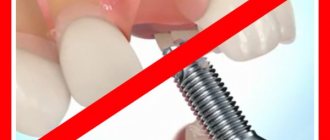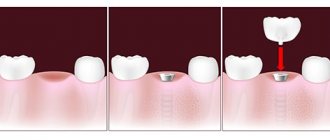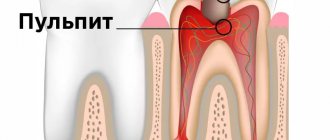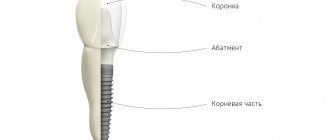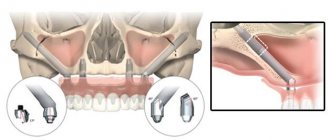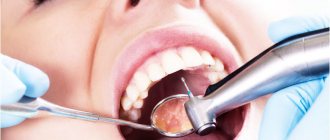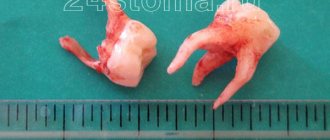In dentistry, an abutment is a connecting part that connects the visible part of the tooth with the internal base on which the entire replacement structure is attached.
These products differ in shape, size and mounting variations.
Typically, the installation of an abutment on an implant is carried out after a certain time to allow the product to fuse with the bone tissue. Often the specified component is not a separate part, but is integral with the internal basis of the structure.
The choice of one model or another is influenced mainly by the initial medical situation.
Types of products offered
Models differ in their functional purpose.
The temporary abutment on the implant is responsible for the formation of the gums. It is fixed immediately after the base is introduced and acts as a “plug,” blocking the path of bacteria into the wound and promoting the healing of the gums above it.
A standard implant abutment can vary in length and also have a different angle of inclination to the base, from 20 to 45 degrees. The angle of inclination is selected taking into account the individual characteristics of the patient in order to maintain the natural appearance of a row of teeth.
The monolithic product is made as a single whole, where the adapter is fused with the implant. Thanks to this design, the treatment process is significantly accelerated and gum injury is reduced.
An individual zirconium abutment for an implant is used in cases of non-standard occlusion and is made for a specific customer.
The design as a whole can be combined and consist of different components made from the following materials: metal, plastic, ceramics.
What types of abutments are there?
There are two main types of construction based on manufacturing method:
- Standard ones are versatile and inexpensive. The installation of a standard abutment is carried out when fixing Nobel Biocare implants, more details about the operation of which can be read at the link.
- Individual . A custom abutment is made using a three-dimensional model, which is simulated by computer programs. In this case, the size, shape, slope and color of the product are ideally selected.
There are also the following types of construction:
- Gum former.
- Angular.
- Straight.
- Globular.
Our team of doctors
Maxillofacial surgeon, Implantologist
Bocharov Maxim Viktorovich
Experience: 11 years
Orthopedist, Neuromuscular dentist
Stepanov Andrey Vasilievich
Experience: 22 years
Orthopedic dentist
Tsoi Sergey Konstantinovich
Experience: 19 years
Endodontist, Therapist
Skalet Yana Alexandrovna
Experience: 22 years
Endodontist, Therapist, Orthopedist
Varvyanskaya Anastasia Andreevna
Experience: 6 years
Dentist-orthodontist
Enikeeva Anna Stanislavovna
Experience: 3 years
Hygiene is an important component of a good result
After installing a dental implant, you must carefully observe oral hygiene:
- It is recommended to carefully rinse the mouth with antibacterial solutions.
- You need to brush not only natural teeth, but also artificial ones.
- It is better to use toothbrushes with soft bristles, no earlier than 2-3 days after the installation of implants.
If you properly care for the oral cavity, complications such as swelling of the gums, severe pain, or discharge from the gums around the installed abutment are quite rare. If this happens, in order to avoid the development of an inflammatory process and implant rejection, you must consult a doctor.
Stages of installing an abutment on an implant
The process of installing this type of prosthesis should be divided into several stages:
- implantation of the structural base;
- securing the gum former immediately after implantation;
- period of engraftment of the base element (about three months);
- removing the “plug”, securing the connecting element;
- installation of the outer part of the dentures.
There is a scheme according to which, under certain conditions, the connector is mounted immediately after securing the implant, bypassing the stage of gum formation. In this case, the patient must be extremely careful to avoid putting stress on the dentures so that the base does not move.
Abutment: what everyone needs to know
Everyone knows what a dental implant is, or at least they can guess. But only a few know what an abutment is and what it is needed for. However, if you are planning to undergo dental implantation in the near future, you need to have at least a general understanding of this important element of the orthopedic design. What function does the abutment perform, and what types exist today – read our article.
What is an abutment
Abutment translated from English means “support”. Indeed, without this small but very important element it would be impossible to install a prosthesis on the implant. Thanks to the abutment, the implant can fully perform its main functions as an artificial root.
Initially, abutments were called supports for bridges, and only after the advent of dental implants did the meaning of the word change
The abutment in appearance resembles a small rod, which is screwed into the implant on one side, and a crown or bridge is fixed on the other. Today, there are various types of abutments, each of which has its own design features and technical characteristics. We will only briefly look at this topic to show how much dentistry has advanced in this matter in recent years.
What are abutments?
Standard
They differ in shape, diameter and size. These are universal orthopedic structures that, if necessary, can easily be replaced with another one. At the same time, they are inexpensive. However, in some clinical cases, additional adjustment of the gingival margins will be required before installing a standard abutment.
Individual
They are made taking into account the anatomical features of the patient’s dental system: bite, shape of teeth and soft tissues. Provide the best performance in terms of functionality and aesthetics. Reduces rehabilitation time. However, such elements cost several times more than standard ones and require a long and labor-intensive manufacturing process.
Corner
They have a certain angle of inclination. Angled abutments provide the tightest connection between the titanium root and the crown in the case when the implant is installed in the bone at a non-standard angle due to the individual characteristics of the jaw structure.
Globular
Such orthopedic structures have a round shape and are most often used with mini-implants to fix a removable denture.
Temporary
It is installed for some time after the dental implantation procedure. Temporary abutments protect soft tissues from the development of infection, promote accelerated healing and aesthetic formation of the gums.
One-piece
They are a monolithic structure consisting of an implant and an abutment. Most often used for single-stage implantation.
There are two ways to fix the abutment: connection on a Morse taper and using a hexagon (internal or external). The first connection option is preferable because it shows better results compared to connecting using an external hexagon. When attaching a crown using a hexagon (internal or external), the edges may become worn down over time, which will lead to mobility of the structure. When connected using a Morse taper, the crown is fixed more securely. Even Formula 1 mechanics use this principle when attaching wheels to a car.
Choose abutments and implants from well-known manufacturing companies that have been working on the market for decades. If such a need arises, you can easily select the required component for the titanium pin
How to care for the abutment
In order for the recovery period to pass as quickly and easily as possible, the orthopedic structure must be properly cared for:
- Try not to injure the mucous membrane in the first days after the procedure.
- Use antiseptics and anti-inflammatory drugs prescribed by your doctor
- On the 3rd day after installation, carefully clean the abutment with a soft toothbrush.
If signs of an inflammatory process appear: swelling does not subside, pain intensifies, fluid is released from under the gum pockets - contact your dentist immediately. You also need to make an appointment with a doctor if the orthopedic structure is loose or the abutment is completely broken. This, fortunately, is extremely rare, and most often occurs in those patients who neglect medical recommendations.
Dental restoration is a serious procedure, the success of which largely depends on the brand of materials, the quality of components and the professionalism of doctors. In the treatment and research center you will receive full dental care and at an affordable price. Call!
Still have questions?
Ask them to our doctor
Care and possible complications
While the gums are adjusting to the implanted element, the patient’s mouth requires special care. It is necessary to clean not only natural teeth, but also all elements of artificial dentures.
It is recommended to treat the connector with a soft brush after three days from the date of surgery. In the previous days, you need to rinse the oral mucosa with a solution with an antibacterial effect.
Sometimes complications occur in the postoperative period. Most often this is pain and swelling of the gum tissue, discharge around the connector. The doctor will quickly eliminate the cause and relieve such symptoms.
Another danger is the instability of the abutment, in which the tightness of the connection is lost, which can lead to infection of adjacent tissues.
Fracture of the connecting element is rare and occurs due to improper fixation. An experienced doctor will quickly eliminate all such problems.
As a system, the implant abutment has been used for a long time; the price of structures and the cost of operations depend on the level of the dental institution, the qualifications of the doctor and the quality of the materials used. The patient can make the initial choice by looking at the photo of the implant abutment on the pages of the Implantmaster clinic on the Internet.
Author:
Manufacturing materials
The most popular materials for making the adapter are:
- Titanium has excellent biocompatibility, high strength, and low cost. The downside is that the metal shows through from under the gums, which is why titanium is used for lateral teeth.
- Ceramics has excellent aesthetics, sufficient strength, and is the material of choice.
- Zirconium has maximum strength, sufficient aesthetics, good biocompatibility, and provides reliable fixation.
- Plastic is rarely used and only temporarily, since the material is fragile.
- Zirconium dioxide and titanium are an ideal alloy for the transition part of the structure. It has high strength and aesthetics, but also has a high cost.
Abutment installation
Stages of dental implantation
Section “Dental Implantation” on Rusmedserv.com
The word abutment has nothing to do with either religion or law and order. It comes from the English word abutment, which in the usual literal translation means “support” or “heel.” In the medical terminology of the last century, dentists used this word to refer to the tooth to which a bridge is attached, i.e. the same bridge prosthesis, which in modern dentistry is increasingly built not on artificial crowns of adjacent teeth, but on implants. In modern implantology, which is slowly gaining independence and no longer wants to be a subsection of orthopedic dentistry, the word abutment has acquired a new meaning. An abutment is a connecting link between a dental implant and a denture or other structure attached to it, for example, a bridge or mini-implant latches for fixing a removable denture.
The abutment is screwed into the implant, but this does not happen as quickly and easily as we would like. The fact is that after installing the implant, it takes several months for it to heal. Only then are all other stages of prosthetics carried out, starting with the installation of the abutment. The time between the implantation of the implant (surgery) and its healing (the period of restoration of the bone structure around the root implant) is not the only explanation for the need to install an abutment in general and the timing of this procedure in particular. A root implant (root-shaped implant) performs the same role as a tooth root, and therefore its location should be similar - the root implant should be surrounded by bone tissue and should not protrude from under the gums. At the same time, the crown part of the tooth must be above the gum and its installation requires the presence of a “transition link”, i.e. abutment.
So, once the dental implants have fused to the bone, the abutment placement procedure is performed. Although this operation is a surgical operation, it is much simpler and painless than installing implants. During this operation, the surgeon removes the cover screws that are needed to protect the implants during the healing process. The abutment is screwed into place of these plugs. Abutments can have different shapes and sizes, depending on the purposes of further prosthetics, but they have one thing in common: one side they are screwed onto the root implant, and the other side faces the future prosthesis. Examples of the appearance of abutments:
Abutments can be ceramic, plastic, metal, or even mixed. The material of the abutment depends both on the future design of the prosthesis and on the choice of the dentist and his patient. After all, all these parameters affect both the price and the quality of the entire structure. In addition to the material, abutments differ in size, shape, diameter of the screw-on part, and even the angle of inclination relative to the implant. The size of the abutment thread is determined, of course, by the diameter of the root implant onto which the abutment is screwed. Abutments are most often ready-made, i.e. industrial, for example: “ Abutment
inclined titanium (15 degrees) for implants 5 mm in diameter." Its length size is also indicated next to it. However, there are individual designs, i.e. manufactured for the specific needs of the doctor and his patient. Modern dentistry is increasingly using computer modeling for this purpose.
Once the dental implant surgery is completely completed and the abutment is in place, no further surgical intervention is usually required. Only a break of 1-2 weeks is required for the tissue around the abutment to heal. After this, you can begin dental prosthetics in various options.
deserves special mention . Just like your own teeth in your mouth, abutments require careful treatment and attention. Becomes extremely important
keeping the abutments and the area around them clean. At first, “sanitizing” the abutments may be slightly painful and unpleasant, but after a few days, when the gums have healed and the inflammation has subsided, the pain will disappear. In the first 2 days, only rinsing is recommended so as not to injure the mucous membrane. Then the abutment is cleaned with a toothbrush. The brush should be soft, and the cleaning process should be gentle but thorough. You can use additional hygiene products, but only those recommended by your doctor.
If, during daily oral care, signs of inflammation persist or even intensify (the gums surrounding the abutment are swollen and painful, any discharge is observed near the abutment), then you should seek help from your doctor. Fortunately, such complications are rare and can be easily cured, so the installation of abutments in general is quite easy and simple for the patient.
